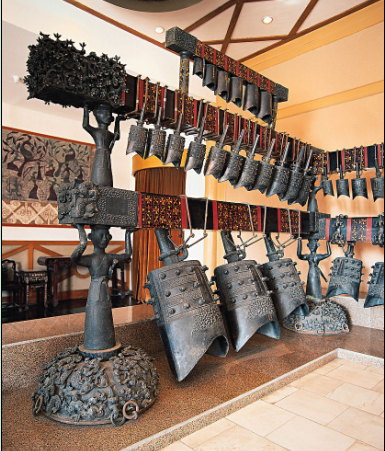Bianzhong: China’s ritual and court music

Bianzhou
Chinese music has a long and intricate history and is intimately tied with the practice of ritual and etiquette upon which the Chinese nation was founded. The history of rites and music is an important component in the history of each dynasty.
Even within early recorded history, the Chinese had developed a very sophisticated and nuanced musical temperament, composing a substantial opus of pieces for a range of instruments. Pre-Qin period (before 221 BCE) music was based predominantly on a pentatonic scale of whole tones, but musicians made use of modified tones and semitones as well. In 1978, people discovered a massive set of bronze chimes (bianzhong) buried in the Tomb of Marquis Yi of State Zeng (circa 2,400 years ago) in Leigudun, Hubei Province. Totaling 65 chimes, the bianzhong is supported by 8 columns and 6 figures of bronze warriors with swords and spans two racks, one 7.8 meters long and the other 3.3 meters long. Each chime emits two tones when struck; they are marked with symbols to indicate the tones. The frequency of the pitch chime (one of 65 chimes) is 256.4 Hz tuned to the equivalent of middle C. Its range spans more than five octaves, with a scale structure similar to the aeolian mode (today’s major diatonic scale). The middle three octaves can produce semitones, much like the equal temperament used on European keyboards beginning around the 15th century, only preceding it by 2,000 years!
The ancient Chinese developed a diverse collection of musical instruments out of an impressive range of materials—gold, stone, soil, leather, silk, wood, lagenaria (a type of gourd) and bamboo. These instruments could be played in a rich variety of styles, ranging from music for court sacrifice ceremonies, other court ceremonies, military music and folk music, music for particular festivals and general music for every day performances.
Qi Hehui is from the School of Literature and Journalism at Southwest University for Nationalities.
The Chinese version appeared in Chinese Social Sciences Today, No. 573, March 19, 2014
Translated by Zhang Mengying
Revised by Charles Horne
The Chinese link:
http://www.csstoday.net/xueshuzixun/guoneixinwen/88404.html

 PRINT
PRINT CLOSE
CLOSE